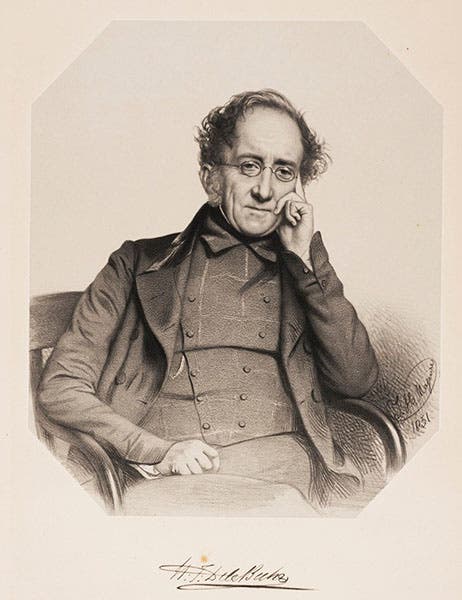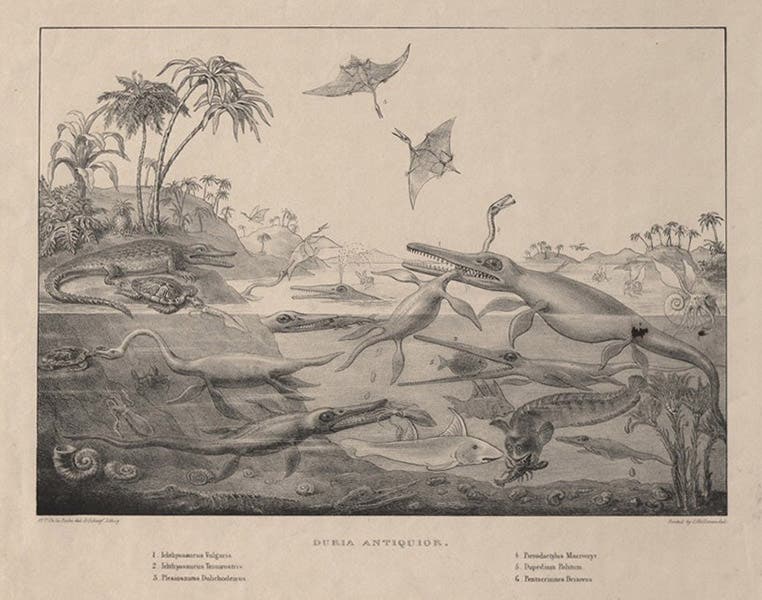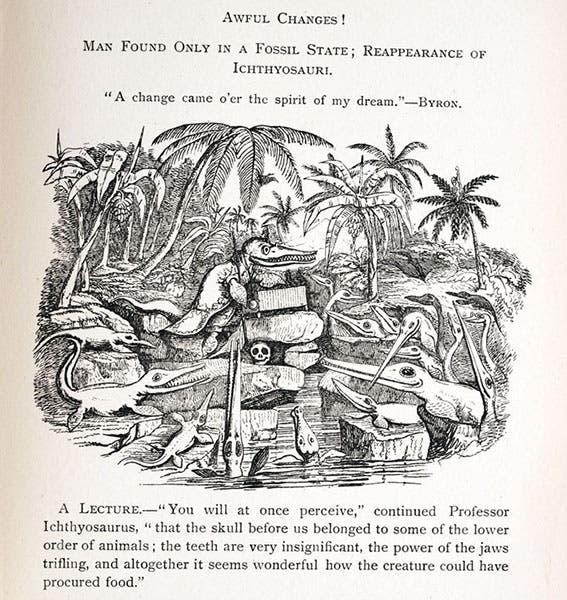Scientist of the Day - Henry Thomas De la Beche
Henry Thomas De la Beche, an English geologist, was born Feb. 10, 1796. He grew up in Lyme Regis, on the south coast of England in Dorsetshire, and collected fossils with the young Mary Anning, who would discover the first English ichthyosaur, plesiosaur, and pterosaur (in 1811, 1821, and 1827 respectively). When Miss Anning ran into economic hard times, De la Beche in 1830 painted a watercolor scene called Duria Antiquior ("A More Ancient Dorset"), which showed ichthyosaurs restored to their native habitat and munching on plesiosaurs, while pterosaurs flew about overhead and ammonites swam in the seas (first image). De la Beche then asked his friend George Scharf to make a lithograph of the painting (third image, below), and copies were subsequently offered for sale, with all proceeds going to Mary Anning.
Duria Antiquior is the very first attempt to depict a scene of prehistoric life. The painting is also of some scatological interest, since the year before, in 1829, William Buckland had been the first to identify certain fir-cone-like concretions as fossilized plesiosaur excrement, which he called coprolites. In De la Beche's painting, the panicked plesiosaur in the vise-like jaws of the ichthyosaur at center is depositing a long trail of future coprolites on the sea floor.
The original watercolor of Duria Antiquior is in the National Museum of Wales in Cardiff and is of course unique. The lithograph prints should be more common, but they are hard to find as well – we do not have one in the Library, and I have never seen one come up for sale. We show here the print in the Museum of the History of Science at Oxford (third image, just above).
In the same year, 1830, De la Beche drew another sketch, this one a caricature, one of the best known in the history of geology. And this one he lithographed himself. Titled “Awful Changes!”, it shows an ichthyosaur lecturing to an aquatic audience about a human skull below his lectern. The caption below reads: "You will at once perceive," continued Professor Ichthyosaurus, "that the skull before us belonged to some of the lower order of animals; the teeth are very insignificant, the power of the jaw trifling, and altogether it seems wonderful how the creature could have procured food."
The object of this puckishness is Charles Lyell, who published the first volume of his Principles of Geology in 1830. Lyell was a uniformitarian, arguing that the Earth is very old and changes appearances slowly, but without progress. When applied to organic life, uniformitarianism implies that life changes but does not evolve; everything comes and goes, so that one could conceivably find ichthyosaurs in any era, and humans as well. De la Beche found that ridiculous, and thus, well, he ridiculed it.
As the “Awful Changes!” print suggests, De la Beche was quite a competent lithographer.� Some years ago, we wrote our first post on De la Beche and focused there on a book of lithographs that he published showing a variety of geological formations. We also displayed in that post a splendid lithograph portrait of De la Beche (1851) by Thomas Maguire. There we showed the entire lithograph, with its wide margins; here we present a cropped version with an enlarged De la Beche (second image).
We may not have the original De la Beche lithographs of 1830 in the Library, but we do have reduced versions of both in a later publication, The Life and Correspondence of William Buckland (1894), by Elizabeth Gordon, the daughter of William Buckland. She presumably included the two prints because her father owned them both. We know Buckland owned an original print of “Awful Changes!”, because that is the copy that sold at Sotheby’s in 2021, for a very healthy price that you can gasp at if you check out Sotheby’s description in their sale catalogue..
Dr. William B. Ashworth, Jr., Consultant for the History of Science, Linda Hall Library and Associate Professor emeritus, Department of History, University of Missouri-Kansas City. Comments or corrections are welcome; please direct to ashworthw@umkc.edu.











